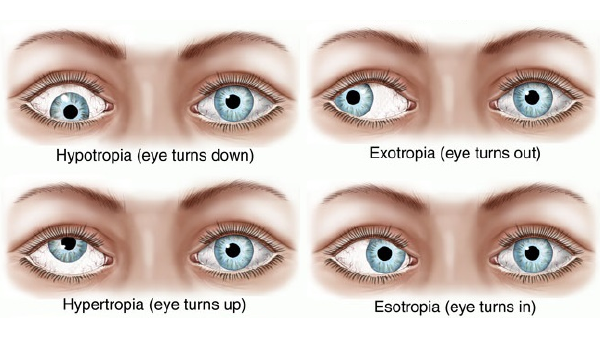Strabismus
Also known as misaligned eyes, strabismus is where the eyes point in different directions.

Strabismus is a visual condition where both eyes are misaligned and point in different directions. Amongst children, strabismus is a quite a common condition that affects about 4% of all children in Australia. This condition is also known to appear in adults, which can result in double vision.
What are the types of strabismus?
- Hypotropia - One eye turns down
- Exotropia - One eye turns out
- Hypertropia - One eye turns up
- Esotropia - One eye turns in
What are the causes of strabismus?
Nerve Palsy
There are six important muscles around the eye that control the eye’s movement and position. These muscles are supplied by numerous nerves. If these nerves become damaged the signal to activate a specific eye muscle is impaired. New born babies that have experienced a traumatic birth and or have developmental issues with the brain centre that controls eye movements can be left with a misalignment.Developmental Issues
A child with developmental delay from common conditions such as Down’s syndrome or cerebral palsy has established numerous affects associated with strabismus. These widely known conditions specifically affect the eyes development of muscle and nerve features. Being diagnosed with these conditions requires the child to undertake routine ophthalmic examinations.Poor Binocular Control
There is a visual centre in our brain that guides our eyes to observe objects together. This provides detailed, sharp and single vision. For some children, this requires more effort and may encourage the brain to shut off an eye and causing it to drift out. Strabismus, such as these, can be improved with patching, eye exercises and glasses to facilitate the relationship between the eyes and the brain to see well together and reduce the rate of the eye drifting out.Eye Muscle Restriction
Occasionally, one of the six muscles around the eye can become trapped or damaged. This limits the amount movement the eye can make and could result in the good eye to look misaligned in certain positions to compensate for the bad eye’s muscle restriction. While muscle restrictions can be acquired form birth, it is more commonly present in people with an injury to the eye or an over-active thyroid
Over Accommodation
A majority of children aged 3-4 years old tend to develop an inward eye turn when focusing at objects up close. This type of strabismus is strongly associated with long-sighted children because they require more focus for close activities than a normal eye would. As a result this additional focusing causes the eye to turn in. This type of strabismus is easily treated with by fitting a pair of prescription glasses from the ophthalmologist.What are the treatment options for strabismus?
It is important to note that if there is any amblyopia (lazy eye) present in combination with the strabismus in any child that the amblyopia is treated first and foremost. Sole treatment of amblyopia can facilitate realigning the eyes. Once the amblyopia is managed, then treatment of strabismus can commence. This typically involves an assortment of treatments including eye exercises, glasses and potentially strabismus surgery.
